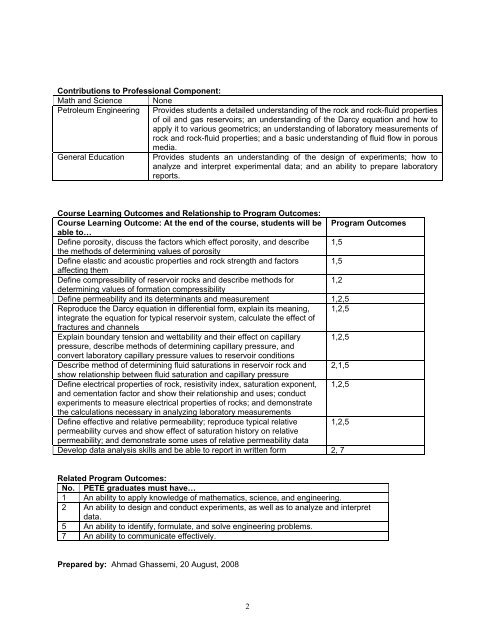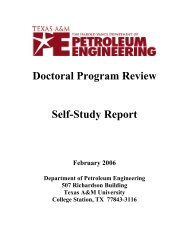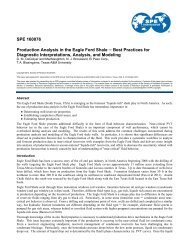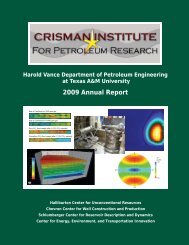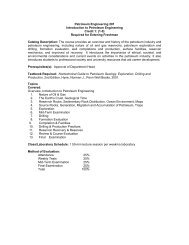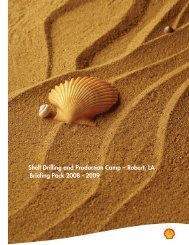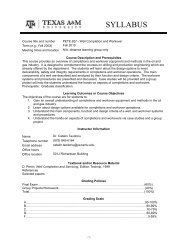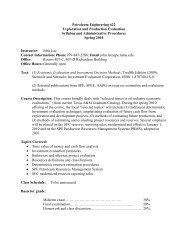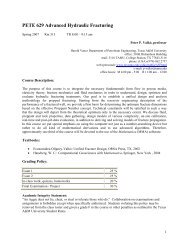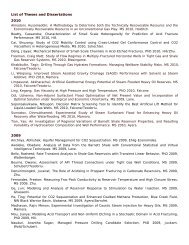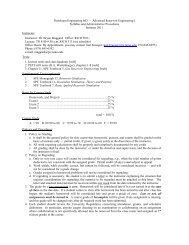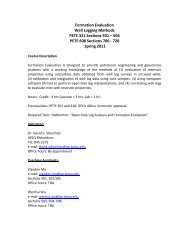Nontechnical Guide to Petroleum Geology, Exploration
Nontechnical Guide to Petroleum Geology, Exploration
Nontechnical Guide to Petroleum Geology, Exploration
Create successful ePaper yourself
Turn your PDF publications into a flip-book with our unique Google optimized e-Paper software.
Contributions <strong>to</strong> Professional Component:<br />
Math and Science None<br />
<strong>Petroleum</strong> Engineering Provides students a detailed understanding of the rock and rock-fluid properties<br />
of oil and gas reservoirs; an understanding of the Darcy equation and how <strong>to</strong><br />
apply it <strong>to</strong> various geometrics; an understanding of labora<strong>to</strong>ry measurements of<br />
rock and rock-fluid properties; and a basic understanding of fluid flow in porous<br />
media.<br />
General Education Provides students an understanding of the design of experiments; how <strong>to</strong><br />
analyze and interpret experimental data; and an ability <strong>to</strong> prepare labora<strong>to</strong>ry<br />
reports.<br />
Course Learning Outcomes and Relationship <strong>to</strong> Program Outcomes:<br />
Course Learning Outcome: At the end of the course, students will be Program Outcomes<br />
able <strong>to</strong>…<br />
Define porosity, discuss the fac<strong>to</strong>rs which effect porosity, and describe 1,5<br />
the methods of determining values of porosity<br />
Define elastic and acoustic properties and rock strength and fac<strong>to</strong>rs 1,5<br />
affecting them<br />
Define compressibility of reservoir rocks and describe methods for 1,2<br />
determining values of formation compressibility<br />
Define permeability and its determinants and measurement 1,2,5<br />
Reproduce the Darcy equation in differential form, explain its meaning, 1,2,5<br />
integrate the equation for typical reservoir system, calculate the effect of<br />
fractures and channels<br />
Explain boundary tension and wettability and their effect on capillary 1,2,5<br />
pressure, describe methods of determining capillary pressure, and<br />
convert labora<strong>to</strong>ry capillary pressure values <strong>to</strong> reservoir conditions<br />
Describe method of determining fluid saturations in reservoir rock and 2,1,5<br />
show relationship between fluid saturation and capillary pressure<br />
Define electrical properties of rock, resistivity index, saturation exponent, 1,2,5<br />
and cementation fac<strong>to</strong>r and show their relationship and uses; conduct<br />
experiments <strong>to</strong> measure electrical properties of rocks; and demonstrate<br />
the calculations necessary in analyzing labora<strong>to</strong>ry measurements<br />
Define effective and relative permeability; reproduce typical relative 1,2,5<br />
permeability curves and show effect of saturation his<strong>to</strong>ry on relative<br />
permeability; and demonstrate some uses of relative permeability data<br />
Develop data analysis skills and be able <strong>to</strong> report in written form 2, 7<br />
Related Program Outcomes:<br />
No. PETE graduates must have…<br />
1 An ability <strong>to</strong> apply knowledge of mathematics, science, and engineering.<br />
2 An ability <strong>to</strong> design and conduct experiments, as well as <strong>to</strong> analyze and interpret<br />
data.<br />
5 An ability <strong>to</strong> identify, formulate, and solve engineering problems.<br />
7 An ability <strong>to</strong> communicate effectively.<br />
Prepared by: Ahmad Ghassemi, 20 August, 2008<br />
2


